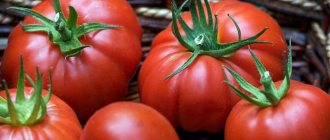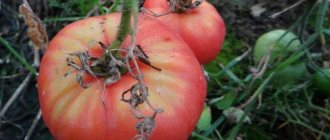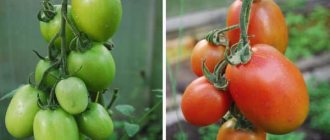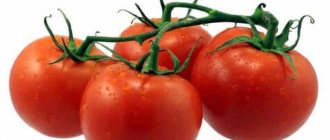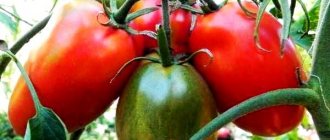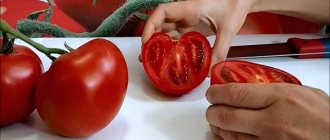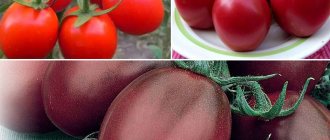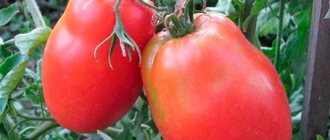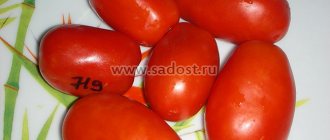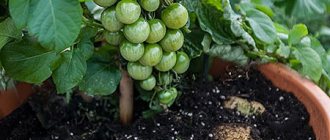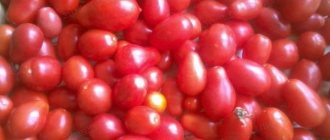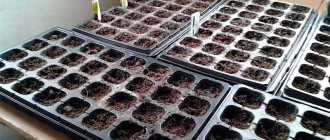Tomato Velikosvetsky f1 is the result of the work of domestic breeders. Highly valued by gardeners and farmers throughout the country. Grown on a large scale for sale.
| Height | Landing location | Ripening time | Fruit color | Fruit size | Origin | Fruit shape |
| Tall | Greenhouse, Open ground | Mid-early | Reds | Average | Hybrid | Heart-shaped |
Description and characteristics of the variety
The Velikosvetsky tomato belongs to the indeterminate type; the bushes grow up to 2 m in height. They require gartering of the main shoots and fruiting clusters with 5-7 tomatoes.
The hybrid belongs to the mid-early variety; ripening occurs 105 days after germination.
Ripe tomatoes are bright red in color, with a beautiful gloss on the barrels. The shape is cuboid, the skin is strong and dense. The fruits are resistant to cracking, transport and store well.
The average weight is 110-120 g. Tomatoes have juicy, fleshy pulp. The taste is rich, with a harmonious combination of sweetness and sourness.
Origin of the variety
The hybrid was born in the breeding room. Agrobiologists have invested in tomato resistance to many pathogens and endurance to unfavorable factors.
Landing region
Tomatoes are grown in the middle zone in greenhouses, in the south in open areas.
Pros and cons of Velikosvetsky tomatoes
Like any variety, the Velikosvetsky tomato has its pros and cons. Strengths include:
- unpretentiousness;
- excellent taste;
- presentation: ripe tomatoes look as if they were painted;
- precocity;
- productivity;
- disease resistance;
- good transportability.
Weaknesses include:
- sensitivity to temperature changes;
- obligatory tying, pinching and bush formation.
Productivity
Velikosvetsky is a productive tomato, yields 5-6 kg from 1 bush, yield from 1 m2 is 12-14 kg. Peculiarities of cultivation and storage
Seedlings are planted in beds at the age of 50-60 days. Choose light loam or sandy soil. The best predecessors are carrots, legumes, and green manure crops.
It is optimal to place the bushes at a distance of 60 cm. 3 plants are planted per 1 m2. Dig a hole 30 cm deep, add a handful of compost, 10 g superphosphate and 1 tbsp wood ash.
Features for caring for tomatoes:
- watering once a week at the root with warm water at the rate of 5-7 liters;
- mulching with straw or sawdust;
- carrying out root fertilizing with liquid mineral and organic fertilizers.
The maximum yield is obtained by growing bushes with 2 stems. Up to 7-8 fruiting clusters are left on the bushes. Stepping is carried out once every 10-12 days.
Tomatoes are picked at the full reddening stage. Ripe fruits are stored for up to 3-4 weeks without loss of commercial properties. Widely used for sale.
Features of cultivation, planting and care
We recommend sowing the seeds of this tomato for seedlings 60-65 days before the intended planting in the ground. Seedlings dive at the stage of two true leaves. When planting seedlings in a permanent place per 1 sq. It is recommended to place up to 3 plants per meter of land; when forming into 1 stem - up to 4.
Further care for tomatoes consists of timely watering, fertilizing with complex mineral fertilizer, pinching and preventive measures to protect against diseases and pests.
When growing tomatoes in a greenhouse, we recommend installing a drip irrigation system - this will save your time and effort, as well as increase plant productivity and reduce the risk of late blight.
Growing seedlings yourself
This variety of tomatoes is perfect for growing both in greenhouse conditions and in open ground. The best option for growing the Velikosvetsky F1 tomato is the seedling method. By following simple rules for planting and caring for this hybrid, you can easily get a large number of high-quality fruits and wonderful taste.
Did you know? In America, the tomato is the most popular vegetable. It is grown in 93% of all US home gardens.
Optimal timing for sowing
To accurately determine the optimal timing, you need to know that sowing is usually carried out 2–2.5 months before planting seedlings in open ground or in a greenhouse.
First of all, you need to focus on the air temperature (the optimal temperature for seedlings is +20 °C), as well as a sufficient amount of sunlight. It’s good if the difference between daytime and evening temperatures is 5–7 degrees - this will harden the seedling, which will make it more resistant to unfavorable environmental conditions in the future. Taking these features into account, sowing is carried out in March-April, in some cases - in early May. The first shoots usually appear 5–6 days after sowing.
Important! Many gardeners and gardeners often rely on the lunar calendar when planting, but the facts of the influence of the Moon on crops have not been scientifically confirmed and are often refuted.
The soil
In order for the seedlings to germinate faster and be healthy, it is necessary to prepare good soil for them. It can be either purchased or made with your own hands. Usually a soil mixture is prepared, which consists of turf soil (1 part), peat (1 part), humus (1 part), sawdust (1 part) and ash (1.5 cups per 1 bucket of the finished mixture).
Growing container
Before sowing seeds, it is recommended to prepare special containers for seedlings. You can use boxes or cassettes, as well as disposable plastic or peat cups. The latter will be needed when the seedlings enter the 2-leaf phase - for their planting.
Seed preparation
Preparing seeds for sowing is the foundation of a good harvest, which is why experienced summer residents begin pre-sowing procedures in late February and early March.
There are a number of preparatory measures that need to be carried out with the seeds before sowing them:
- Sorting and culling - Heavier and larger seeds are known to produce healthier, more fertile plants. To select such specimens, the seeds are immersed in a previously prepared saline solution (1 teaspoon of salt is dissolved in a glass of water and left for about 10 minutes). Full-bodied seeds sink to the bottom of the glass, and small and dry seeds float to the surface (they need to be removed).
- Disinfection - It has long been known that many plant diseases can function on the surface of seeds. To avoid this, all seeds undergo a disinfection procedure before planting - kept for about 20 minutes in a 1% solution of potassium permanganate or 7-8 minutes in a 3% solution of hydrogen peroxide heated to +40 °C.
- Impregnation with nutrients - to improve the quality of yield, seeds are soaked in special solutions for 24 hours before sowing. You can use folk recipes - aloe or potato juice or industrial preparations. After soaking, the seeds are dried without washing.
- Germination - to accelerate the growth of seedlings and earlier ripening of the crop, before sowing, tomato seeds are left in a saucer covered with damp gauze or wet filtered paper.
- Hardening - to increase the resistance of tomato bushes to adverse weather conditions, as well as to increase the quality and quantity of the harvest, before planting, tomato seeds are placed 2-3 times in the refrigerator overnight (at a temperature of 0 ... -2 ° C) for 12 hours.
Even using one of the above methods of seed treatment before sowing, you will significantly increase the quantity and quality of your harvest.
Did you know? For a long time, tomatoes were classified as poisonous plants. Gardeners used them as exotic ornamental plants.
Sowing seeds
Before planting the seeds, the prepared container is filled with soil 3 cm below the edge. After this, the soil mixture is watered and, covered with film, left for a day - this will allow moisture to evenly penetrate the soil. Immediately before sowing the seeds, the soil in the container is leveled and holes no more than 1.5 cm deep are made where the seeds are planted. The top of the container must be covered with polyethylene, which artificially creates high humidity. To accelerate the emergence of sprouts, the ambient temperature should be at least +25 °C. After the first shoots, the film is removed to avoid the appearance of rot.
Seedling care
The first shoots usually appear approximately 7–8 days after sowing the seeds. During this period, it is very important to have a sufficient amount of light and adherence to the temperature regime - after the first shoots appear, the temperature must be lowered to +15 ° C for 5-6 days. After this, allowing the sprouts to get stronger, the daytime temperature rises to +24 °C, and at night - to +12 °C. After the first leaves appear, the seedlings should be pricked - to grow the root system, the main root is pinched when pricked.
Seedlings of this tomato variety need feeding. Fertilizers are introduced for the first time on the 10th day after planting, the second time - two weeks after the first. As a top dressing, you can use ready-made commercial fertilizers or prepare them yourself. To do this, 4 g of urea, 30 g of superphosphate and 10 g of potassium sulfate are diluted in 10 liters of water and the soil is watered with this solution.
The main care after fertilizing consists of watering and loosening the soil. It is worth paying attention to two important factors for the healthy growth and development of plants: light and water. To avoid diseases and even death of seedlings, watering should not be excessive, and there should be enough light.
Find out also about the Kumato variety of black tomatoes.
Hardening of seedlings
Hardening off seedlings is a very important procedure, allowing the tomato bushes to easily withstand adverse weather conditions in the future. The hardening procedure usually begins 2 weeks before planting seedlings in open ground. To do this, after waiting for warm spring days, when the air temperature has warmed up to at least +12 °C, the seedlings are taken outside. Such procedures should begin with half an hour and gradually increase the amount of time the seedlings spend in the air.
When hardening, you should avoid exposing the plants to direct sunlight and ensure there are no drafts. Hardened seedlings can then easily withstand the first autumn frosts, when the air temperature can drop to -5 °C.
Description of the variety
The plant is heat-loving, so greenhouse cultivation of bushes is recommended. An exception may be open ground in the southern regions. In this case, seedlings are planted only after frosts and sudden temperature changes have completely stopped.
Tall bushes require careful, timely tying, as well as mandatory pinching. The most productive bushes are those with two main stems. About 5–7 fruits grow on one cluster. It is recommended to place the first flowering cluster above the seventh leaf, and each subsequent one after another 2–3 leaves.
Tomatoes have a rich sweet taste and thick, thin skin, but require full ripening on the bush itself. Early picking of unripe tomatoes can affect both the taste (the appearance of sourness) and the duration of storage (keeping quality).
Reviews from gardeners
Reviews from those who planted this hybrid are extremely positive.
Valentina, 45 years old, Oryol region This year another hybrid from the Partner appeared in my greenhouse - Velikosvetsky. Summer came so late this season that we had to cover the seedlings with spunbond even after planting them in the greenhouse. But the plants were strong, they all took root well. The tomatoes bloomed early, and the first fruits appeared at the end of July. I like the dense clusters of the Velikosvetsky tomato with fruits of the same size, as if by choice. There were not many tomatoes in the first clusters, 3-4, probably due to the cold weather. And when the heat finally set in, 6-8 fruits began to form in the cluster. I was pleased with the shelf life; the tomatoes that didn’t have time to spin right away lasted until winter.
Tatyana, 39 years old, Bryansk The seeds of this crop were distinguished by 100% germination and the seedlings looked strong, only slightly elongated. For the experiment, I grew Velikosvetsky in different ways: I formed it into one, two shoots or more. On the bush where I left one stem, the largest cluster ripened - 1028. But I liked the harvest more on other bushes, which I formed into 3 or more shoots, only cutting off the lower leaves. There I got 15 kg from two bushes. What I liked about the Velikosvetsky tomato is that the trusses have time to fully ripen and at the same time the very first tomatoes do not crack, as happens with other varieties.
Advantages and disadvantages of the variety
The most significant advantage of Velikosvetskie tomatoes, which is noted by almost all summer residents, is their high yield. The tomatoes are not only tasty, but also juicy, and they are oversized, which allows the fruits to be used in a wide variety of dishes and preparations.
Velikosvetskie tomatoes are one of the highest-yielding hybrids
pros
- excellent yield;
- good taste of fruits;
- can be grown in most regions;
- good transportability and keeping quality;
- high immunity to diseases.
Minuses
- The variety is heat-loving, does not like temperature changes;
- it is necessary to tie up, pinion and form a bush.
Advantages and disadvantages
The Velikosvetsky tomato is distinguished by a whole range of advantages:
- relatively early ripening combined with high yield;
- increased resistance to diseases and unfavorable growth conditions;
- beautiful, one-sized, non-standard-looking fruits with tasty pulp;
- increased shelf life and excellent transportability.
Turkmen horse - Akhal-Teke horse, description of the breed
Of the relative disadvantages of this tomato, only the need for mandatory formation and garter of bushes is noted, which is sometimes difficult for beginners and busy summer residents.
Description of the hybrid
The Velikosvetsky variety appeared as a result of the efforts of breeders of the Partner agricultural company, located in the Moscow region. It recently spun off from a well-known seed production company, but has already managed to make a positive statement about itself, including the production of interesting varieties of vegetables and flowers.
In 2021, one could congratulate the Velikosvetsky f1 tomato on its inclusion in the State Register of Breeding Achievements of Russia.
Velikosvetsky tomato plants are obviously classified as indeterminate species. Even in open ground conditions, the bushes are tall - their height reaches 1.5 meters. But in central Russia it is recommended to grow this hybrid in greenhouse conditions, where, depending on its formation, it grows up to two meters and higher. In polycarbonate or glass greenhouses it is able to show maximum yield at very early ripening periods (105-110 days from emergence to the redness of the first fruits).
Better prospects for your health || Better prospects for your health || Better prospects for your health || Better prospects for your health || cinnamon stick
However, if the summer is warm, the tomato will feel good under ordinary covers with non-woven material of sufficient density (from 60). Moreover, these shelters will be needed mainly at the stage of planting seedlings in the ground in order to protect them from return frosts.
Productivity is one of the strengths of the hybrid variety Velikosvetsky. The tomato demonstrates truly unprecedented performance - up to 5 kg of tomatoes are harvested from a bush. And per square meter - up to 20 kg.
The tomato will appeal to beginners and those who do not like to stuff their vegetables with chemicals. After all, the originators claim that the Velikosvetsky tomato has increased resistance to a number of nightshade diseases, primarily late blight, tobacco mosaic virus, fusarium and various bacterial infections.
It also withstands numerous weather conditions well: cold, prolonged rains, heat, drought and even hail. Where most other tomatoes would disappear or produce a minimal harvest, Velikosvetsky withstands adversity and delights with unusual fruits.
How does a hybrid grow in open ground?
The hybrid grew remarkably well in a greenhouse and, in my opinion, grows well in open ground. By forming plants into 2-3 stems, we achieve a reduction in its growth and faster fruiting, so plant the “Velikosvetsky” hybrid in open ground. It grows no worse than in a greenhouse. The only thing is that you need to grow it in 3 stems and you can plant it a little thicker. Approximately 4 pieces per square meter. Not 3, but 4 pieces.
